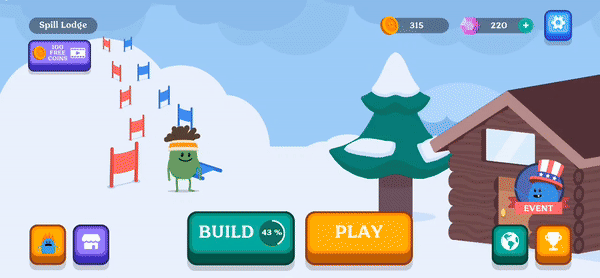Dumb Ways to Die 4
Responsibilities:
-
Pitching the high-level vision and iterating stakeholder feedback.
-
Creating and iterating the core-gameplay loop and monetisation strategies of the title.
-
Working closely with engineers during pre-production to concept tools that would speed up the minigame implementation process.
-
Liaising with both internal and external developers to maintain a consistent understanding of the title's core design pillars .
-
Writing and maintaining documentation, including; the game design document, economy spreadsheets and external feedback.
-
Consistent playtesting, bug tracking and pacing tweaks of moment-to-moment gameplay.
-
Onboarding and helping to upskill the junior design members of the team.



Case Study: Increasing Player Retention
Marking my first experience as lead game designer, the primary goal of Dumb Ways to Die 4 was to investigate how we could increase player retention compared to that of the original Dumb Ways to Die title which still had an active audience. First, I took a step back from the series and created a player survey that aimed to garner some insight on the preferred play habits and genres of games that our audience most engaged with, by comparing this audience data to other titles in the casual-mobile market we determined a strong correlation in our existing audience and decoration games.
The original Dumb Ways to Die title had a lightweight mechanic wherein the player unlocked decorations for a train station platform, and by using this as a basis, I pitched a more robust, polished system that aimed to create a strong incentive to jump back into another round of minigames for "just one more run" while simultaneously remaining unobtrusive for players who do not want to engage with the system.
In Dumb Ways to Die 4, instead of automatically earning and placing decorations for the train platform as you play minigames, a player earns currency that can be used to purchase the next decoration for that section of the world. Allowing the player to choose when they decorate ensured that players deep in a minigame flow-state are never interrupted by the metagame and provides a stronger sense of autonomy when they do choose to engage, a feeling that is exemplified further in the light, branching-paths of the decorations.

Branching decoration paths allow small moments of player expression.

An example of a completed environment in DWTD4.
Furthermore, by allowing players to decorate a series of smaller, more visually-rich environments we aimed to increase retention by creating a sense of finality and completeness to each space. The original Dumb Ways to Die gave the impression that decoration and minigame unlocks are unlimited and thereby did not encourage players to set long term goals during a play session where, in comparison, Dumb Ways to Die 4 creates a measurable sense of progress in each environment by having them transform from bland, unfinished lots into bright and colourful backdrops before moving to the next.
This modernised iteration of the metagame loop created a strong baseline retention for us to continue to improve upon during live-ops and further supplementary systems such as character abilities, limited-time events and themed minigame unlocks ended in a product that successfully achieved our goal of increasing the retention of the Dumb Ways titles.

